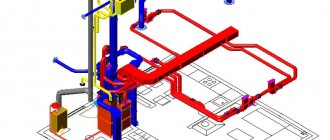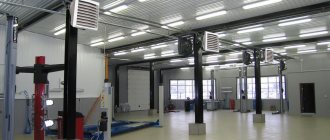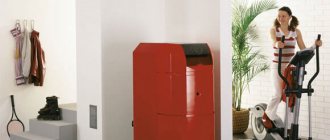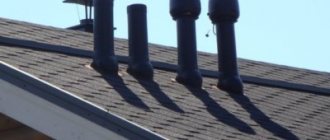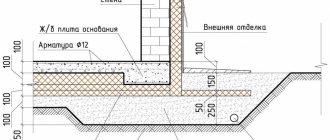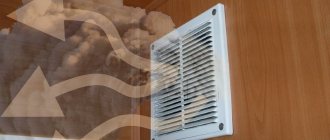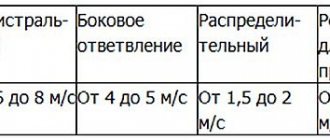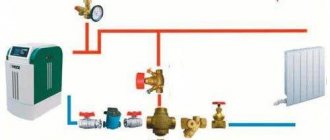Loading…
Loading…
The rooms in which winter supplies are stored cannot function without regular air exchange. Therefore, the question of how to properly make a hood in the cellar must be resolved in advance, so that by the time of harvesting the air in the vegetable storehouse will delight you with stable dryness and cleanliness. Only in this case, the carefully collected gifts of summer will be able to last until the new season without signs of spoilage and rotting.
What are the consequences of lack of air exchange in food storage areas?
Unfortunately, not every thrifty owner wonders whether ventilation is needed in the cellar and understands the importance of creating a suitable microclimate in the underground pantry.
After all, numerous sheds, gazebos, and country houses do not require additional expenses for ventilation. Why spend money on a separate hood in the basement, which is not visited very often? The answer is simple and obvious: in a poorly ventilated room, humidity inevitably rises and putrefactive microorganisms begin to develop rapidly, capable of turning environmentally friendly products into foul-smelling waste in a short time.
According to food production technologists, a properly equipped hood in the cellar should provide the following conditions:
- air humidity within 85–90%;
- temperature from –1 to 4 °C;
- absence of sudden changes in these parameters.
At a humidity level of less than 75%, root crops dry out and wrinkle; at 100%, there is a risk of condensation forming and subsequent spoilage of the product.
Maintaining a stable temperature is largely achieved by sufficiently deepening the vegetable storage in the ground and proper insulation, which prevents the cellar from freezing in severe frosts and excessive heating in hot weather.
Ventilation system calculation
In this example, the ventilation duct made from a regular polyvinyl chloride (PVC) pipe will be used as a basis.
- In the case when the total area of the cellar is 10 sq.m., then we need an air duct area equal to the product of 10 by 25 sq.m. cm. It turns out 250 cm square.
- Next, we take the formula for the area of a circle (our duct is round) S = πR², according to which we calculate the required radius of the ventilation pipe, which in our case will be 8.9 cm. Accordingly, the diameter of the pipe should be 17.8 cm.
In the case where the PVC pipe has a non-standard rectangular cross-section, for our basement it should be about 16 cm. If you need to make a calculation for another area of the basement, it will be similar.
The above calculation is very simplified, since it does not take into account the intensity of air exchange in the room.
It is necessary to take into account the fact that optimal ventilation implies a complete change of air in the cellar at least once every half hour.
Experts often recommend calculating the cross-section of the ventilation duct in the basement, taking into account air flow. Interestingly, for calculating air flow there is also a formula: L=V*K, where L is, in fact, the air flow value we need, V is the total volume of the basement, and K is a value indicating how many times per hour the air in the room changes. If, for example, the height of the basement is 200 cm, then the air flow calculated using the above formula will be about 40 cubic meters. at one o'clock.
Types of ventilation systems
The movement of air in a room is always subject to the laws of physics. Knowing them, it’s easy to imagine how to properly make a hood in the cellar to remove excess moisture.
The owner has three options for arranging ventilation:
- The vent system guarantees minimal air exchange and consists of several holes in the basement of the building. Vents are located no lower than 0.3 m from the soil level and are covered with bars to prevent rodents and small animals. To regulate the temperature, the vents are equipped with valves. Arranging even such a simple outlet in the cellar solves the problem of short-term storage of vegetables or preparations.
- Natural ventilation consists of two pipes mounted at different heights. Heavier, cold air enters the room through a long pipe that reaches almost to the floor level, and lighter, warm air rises up and exits through a short exhaust pipe. In a mild case there may be only one pipe. This is the simplest way to build a hood in the cellar with your own hands. Air movement in this case occurs with fluctuations in internal and external pressure.
- Forced ventilation provides the best ventilation and is able to maintain stable temperature and humidity levels. This is achieved by installing one or more fans.
A running fan creates a rarefied atmosphere, as a result of which the room is quickly filled with fresh air from the street.
Ventilation functions
In order to do the work correctly and with your own hands, you first need to know what ventilation is for and what its functions are. After all, the price of the issue lies not only in the correct storage of vegetables in the basement, but also in the safety of the machine. And this is already extremely important.
Schematic diagram of ventilation operation
So:
- If there is a cellar in the garage, ventilation will perform the function of removing excess moisture. After all, it will not harm vegetables, but it will have a detrimental effect on the car;
- Ventilation will also remove vehicle exhaust gases, which are extremely dangerous to human health.;
- Ventilation will also contribute to the safety of the car, this is especially noticeable in winter. When you put the car in the garage, then the melted snow will damage the body. While ventilation will remove excess moisture;
In what cases is natural exhaust sufficient?
The main reason for the lack of forced supply and exhaust ventilation in the cellar is the impossibility of supplying electricity. If the vegetable storehouse is small and the supplies are placed freely in it, there is nothing to worry about - two pipes of different heights will ensure a normal microclimate and the safety of the products.
An extensive cellar, divided into sections, must be equipped with exhaust and supply pipes in several places. Their location should be thought out in such a way as to prevent prolonged stagnation of air in distant nooks. It is in them that mold will begin to multiply and spread throughout the storage facility.
When calculating the number of pipes, follow the rule: for every square meter of the basement there must be at least 26 square meters. cm cross-sectional area of the ventilation duct.
The diameter of the pipes is calculated as follows:
- measure the floor area in square meters. meters;
- the resulting number is multiplied by 26;
- the product is divided by the number π, then the square is found. The root and the result are divided by 2.
The exhaust pipe can be 10–12% larger than the inlet diameter.
Plastic, wood, stainless steel or galvanized steel are used for ventilation devices. Asbestos pipes should not be used - particles of the mineral can cause allergies, cancer and other health problems.
How to install a supply pipe
Supply ventilation diagram
The supply pipe is installed on the opposite side of the room. It should be located half a meter from the floor. This pipe is led to the roof and is equipped with a grating to prevent dirt and protection from precipitation. So:
- In practice, it is clear that with a shorter supply pipe the air exchange will be stronger, but the pipes cannot be placed at the same level, otherwise air stagnation will occur.
- With such a simple design, you will quickly achieve a favorable climate in the cellar, saturated with oxygen and with a sufficient level of humidity.
- To check the ventilation in the cellar, just light a candle. If the fire is even and bright, then everything is in order with air exchange.
- If the match goes out immediately, this will mean that there is not enough carbon dioxide in the room, and air exchange is not happening properly.
- To find out which pipe has a snag, a match or burning paper comes to the rescue again. It must be brought in turn to one or the other pipe.
- If the flame is trembling, this will indicate a flow of fresh air. If this does not happen, it means that the air duct is clogged or there are errors in the design.
Advice. In this case, you need to change the height of the flow pipe to speed up the flow channel. This did not help - the diameter of the pipe should be increased.
- If the air ventilation is correct, and excess moisture collects in the cellar, you can place a container with slaked lime below, which will remove excess dampness.
- The main advantages of a flow-exhaust hood for a cellar are its durability, reliability and simplicity of design.
For a visual example, we recommend watching a video on how to make a hood in the cellar. With its advantages, such an exhaust system also has its disadvantages.
One drawback is that the hood depends on the difference in temperature and on the strength of the wind; the cellar will be well ventilated only if the difference is large.
Forced ventilation will solve all problems with high humidity
A simple and trouble-free system of two pipes of different heights almost never fails, but the need for additional expenses may still arise.
This happens in the following cases:
- extremely weak natural air circulation in the cellar occurs due to the terrain;
- high groundwater sharply increases the humidity of the vegetable storage during snow melting;
- the basement has a significant area, but its design does not allow installing a sufficient number of ventilation ducts;
- the room is used not only for storing supplies - in the basement it is easy to equip a gym, an additional living room, a storage room or other utility room.
If you plan to make the basement space residential, you can no longer do without forced ventilation - the accumulation of carbon dioxide unnoticed and quickly leads to death or serious health problems!
Installation of forced ventilation in the basement
The forced ventilation system in the basement under the garage uses the principle of supplying fresh air, regardless of the temperature conditions outside the room.
The fan is installed on the inlet pipe
Due to windless weather, the air temperature outside in the summer is often higher than in the cellar. This problem can be solved using a fan.
Before installing the exhaust system, you need to carefully consider the location of the fan. It cannot be mounted in a cellar or on the roof: it is a complex electrical appliance that will fail if exposed to moisture. Due to increased noise, it is not recommended to install it inside a garage.
There are two options:
- Install a fan on the inlet pipe in the place where air is taken in. The entrance to the canal is additionally protected by a mosquito net. Due to the fact that the pipe outlet is located low, it is necessary to monitor the snow level in winter.
- Install a duct fan.
The first part of the installation of a forced ventilation system is no different from the natural one. Inlet and exhaust pipes are installed. The inlet pipe goes from the ground to the cellar, the outlet pipe goes from the basement ceiling through the garage roof or goes out parallel to the floor and rises outside the room.
Further installation occurs in stages:
- A fan is built into the pipe.
- The cable for powering the fan is laid.
- The switch is installed.
- From the outside, the exhaust pipe is covered with a fine-grained grill to protect against rodents, birds, and random debris. A protective canopy is also installed to prevent precipitation from getting inside.
Connection details can be seen in the video.
Video example of correct connection
How to properly make a hood in the cellar under the house
how to properly make a hood in the cellar The location, dimensions and depth of the basement are calculated at the stage of designing the house. The vegetable storage pit is dug and the floor is concreted at the same time as the foundation is poured, in which vent holes should already be provided. When laying electrical wiring, it is necessary to take into account lines for lighting, installation of fans and other climate control equipment: sensors, weather stations, relays and automatic machines.
All electrical equipment must be reliably insulated and have an appropriate degree of protection from moisture. An excellent option would be to use a 36 V network.
When constructing an underground storage room, special attention should be paid to waterproofing. In the future, this will help reduce the cost of ventilation and sanitary work to destroy mold and harmful insects - wood lice, two-worts, millipedes.
The inlet and outlet pipes must be kept as far apart as possible so that fresh air flows throughout the entire room. The inlet opening should not be located directly next to the products - in severe frosts this can cause the vegetables to freeze. To prevent the formation of condensation, the inlet pipe is insulated with foam rubber. Ventilation ducts are laid without unnecessary bends, narrowings and expansions, so as not to reduce draft.
Video description
The video shows how such ventilation is arranged in a concrete garage:
However, in small cellars built in dry soil, well-waterproofed and insulated, natural ventilation works well and copes with its functions.
See also: Catalog of companies that specialize in ventilation and air conditioning
Forced ventilation
If you need to decide how to properly make a hood in the garage basement so that there is no dampness, then the already described system should be equipped with a supply and exhaust fan. They come in different types:
- Duct - installed on ventilation ducts.
- Centrifugal and axial - mounted in openings in the wall.
Duct fans are easily installed in the system due to the coincidence of the installation diameter with the diameter of the pipe Source cdn.fotosklad.ru
These mechanisms can be selected according to the power and volume of air exchange, many of them are equipped with a timer and speed controller.
Advice! Choose fans in a waterproof casing and be sure to insulate the electrical wiring from moisture.
Such a system will cost much more due to the cost of equipment and its installation, as well as due to the constant costs of paying for electricity. In addition, fans that are turned off, especially those equipped with a check valve, create a barrier to the natural flow of air.
But it also has many advantages, especially if you need to solve such a complex problem as how to properly install ventilation in a large basement with difficult operating conditions:
- The system will remove humid and chemical-contaminated air outside, regardless of the outside temperature.
- The air exchange rate can be set by installing fans with the required parameters depending on the needs of a particular room.
- The microclimate in the cellar is normalized, so that fungus does not appear in it, and the products remain fresh for a long time.
How to choose a fan
The market offers devices of three types - axial, channel and centrifugal. For installation in basements, axial and channel ones are used. Centrifugal units are distinguished by their high power and dimensions, and are used in industry and large agricultural enterprises.
Axial ones are easy to install, versatile and effective. Duct units are installed in air ducts and equipped with humidity and automatic shutdown sensors.
A device of any type is installed on the exhaust pipe so that the operating impeller draws air out, creating a rarefied atmosphere.
Why do you need a deflector?
If there is no power supply for forced ventilation, wind energy can help.
To do this, a deflector is mounted on the hood from the cellar, which consists of three main elements:
- the diffuser has frequent through holes and is placed on the outlet channel;
- the cap protects the entire device from precipitation and small debris;
- the body connects the parts using brackets.
The principle of operation of the deflector is to cut air flows with a diffuser and draw air masses into a pipe in which a rarefied atmosphere is created. This creates additional draft, accelerating ventilation.
A correctly installed deflector increases the efficiency of the entire system by 15–20% and significantly reduces the likelihood of reverse draft.
Some models of deflectors are equipped with a protective mesh that traps dust and insects, but can weaken the draft. To increase ventilation power, the mesh can be removed.
Inexpensive plastic or galvanized models are suitable for installing a hood in the basement. Ceramic or copper deflectors are expensive, but serve as a stylish and status decoration.
Operating principle and purpose of the system
Organizing a microclimate is a complex task, to achieve which a whole range of means, materials and techniques are used. One of the stages of designing a cellar is the selection and installation of a ventilation system. Lack of air circulation is considered a serious problem that can negate all efforts to harvest and prepare crops for the winter. In a room with insufficiently functioning or completely absent ventilation, the following phenomena develop:
- air stagnation;
- increase in humidity;
- increase in indoor temperature;
- acceleration of decay processes;
- the appearance of condensation;
- development of mold fungi;
- activation of corrosion processes.
As a result of such factors, food and all other attributes in the room suffer. Racks quickly rust, shelves rot and collapse, lids oxidize, vegetables and fruits rot, and the air becomes unbreathable. Effective ventilation guarantees the storage of products, increasing the service life of shelving and all related equipment.
There are several ways to achieve complete circulation of air masses inside the cellar. However, the most effective among them is the design of a natural supply and exhaust system with two pipes. The principle of its operation is determined by the temperature difference between the environment and the cellar. From a school physics course it follows that heated air evaporates, rising to the ceiling. At the same time, its place is taken by cooled masses, providing the necessary circulation of flows. A similar effect can be achieved indoors by using a simple system consisting of two pipes.
Supply and exhaust ventilation diagram
Automatic climate control in the cellar
The simplest device that helps monitor air parameters is a psychrometric hygrometer. It has two scales and shows relative humidity and temperature. For a cellar, you should choose a device with a temperature scale from 0 to 25 °C.
A weather station with a remote sensor will allow you to check the condition of the storage directly from home.
When choosing a weather station, you need to pay attention to the length of the wire. The distance must be measured from the floor of the cellar to the place where the device itself will be located, or choose a wireless model.
If the vegetable storehouse is located separately from the house and there is light connected to it, the best solution would be to install humidity and temperature sensors operating in automatic mode. When the indicators leave the specified range, the valves automatically open or close. Fans turn on or off, quickly bringing the microclimate back to normal.
Automation in this case allows you to solve two issues at once:
- how to properly make a hood in the cellar;
- forget about the problem of poor preservation of the harvest.
Preparing the cellar for permanent use
The installation of ventilation in the basement intended for storing food does not end with installation work. To ensure a normal microclimate in the cellar, it is necessary to dry it well, check the efficiency of the system and follow certain rules during further operation.
Ways to dry a new room
Before you start drying the cellar, you need to check the efficiency of the installed system. This is due to the fact that moisture must be removed during drying and the easiest way to do this is through an exhaust pipe. To test, roll up an old newspaper and wait for it to burn about a quarter of the way through.
After this, extinguish it so that it continues to smolder. If the smoke from the newspaper is freely removed through the hood, then the system is working normally, if not, then you need to once again check the correctness of the calculations and the height of the outlet of the pipe head.
Drying should be carried out in the warm season, before storing food in the cellar for storage. The essence of common and accessible drying methods is to increase the indoor air temperature, which will provoke increased air exchange and removal of evaporated moisture through the hood.
Moisture-absorbing materials
It is possible to use hygroscopic substances, such as quicklime, calcined table salt or expensive technical silica gels that actively absorb moisture. These are very time-consuming methods and also require additional financial costs.
Flame at the entrance to the exhaust pipe
If you light a large candle or a simple alcohol lamp and bring it to the exhaust vent, the air will begin to heat up and the circulation will increase. Dry and warm air coming from the street will begin to warm up the cellar, actively absorb moisture and go outside. However, more than one candle is required and the process takes several days.
